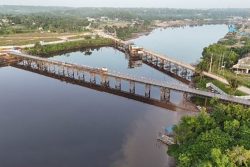With the pipelines that form part of the massive proposed US$900 million gas-to-energy project having the capability to transport up to 120 million standard cubic feet per day (MMSCFD) of gas from Liza Phase 1 and Liza Phase 2 FPSOs, studies are being done to consider alternative uses of the natural gas.
British consultant and gas-to-shore veteran, Simon Shaw, made this disclosure at the Environmental Protection Agency’s (EPA) virtual scoping meeting which is intended to craft the terms of reference for the Environmental Impact Assessment (EIA) for the US$900 million project to pipe associated gas from Guyana’s offshore oil wells to be transformed into energy at a plant in Wales, West Bank Demerara.
Esso Exploration and Production Guyana Limited (EEPGL) and its co-venturers submitted an application to the EPA in June this year for an environmental authorisation. The company notes in the summary that it entails the construction and operation of a 12-inch pipeline, approximately 220 kilometers long, from the Liza Phase 1 and Liza Phase 2 Floating, Production, Storage and Offloading (FPSO) vessels in the offshore Stabroek Block, to an onshore natural gas liquids (NGL) and natural gas processing plant located at Wales. The pipeline is expected to transport up to approximately 50 MMSCFD of dry gas to the natural gas liquid plant but has a maximum flow of approximately 120 MMSCFD.
Among participants in yesterday’s scoping meeting were the Chairman of the Gas to Shore Task Force, Winston Brassington; Senior Petroleum Coordinator, Bobby Gossai; British Consultant and gas-to-shore veteran, Shaw; Executive Director of the EPA, Khemraj Parsram; and EEPGL representative, Friedrich Krispin.
Answering a question posed by Director of the World Wildlife fund-Guianas Dr David Singh, Shaw confirmed that studies are being done to find a suitable alternative apart from energy use, while noting that some of these may benefit the agriculture and aquaculture sectors.
“There are many uses for gas and we need to find the uses of gas for something else,” he suggested.
That disclosure was made after Brassington pointed out that the minimum 50 MMSCFD of gas will only be during start-up period after which daily production can increase hence the need for other uses of the gas.
According to Brassington, Guyana will pay for its share of the gas. However, he said the final agreement between Guyana and EEPGL is still to be completed and noted that construction is not expected to commence until mid-next year so in the meantime the final details will be ironed out and negotiated.
Meanwhile, after several persons raised concerns about insurance coverage, Parsram stated that consideration for financial coverage will be included in the environmental permit if environmental authorisation is given.
As part of his presentation at the beginning of the meeting, Krispin pointed out that EEPGL was asked by the Government to assist with the project in the years to come but added that they are happy to be part of the project. He went on to state that Guyana would be rid of “erratic” power problems and that the country’s current source of energy is not environmentally friendly.
“We believe that natural gas will reduce our carbon-footprint” he opined. He added that the final onshore route for the onshore pipeline is still to be determined but this is expected to be done within the next few months after engineering studies are completed. He later clarified that the final route will be within the 200-kilometre route that was chosen by the government after participant Janelle Christian asked why the go-ahead to conduct an EIA was given if those plans are not finalised.
Alternatives
Another participant, Vishnu Doerga, asked about the studies that were done to determine the location of the Wales power plant and what the alternatives were. He was directed to the Ministry of Natural Resources website. Gossai in his capacity pointed that the studies done in the past relates to gas-to-power so the studies that are available are not specific to the current project.
Doerga also asked if EEPGL will be buying land that falls directly in the path of the onshore pipeline before construction begins, but this question was not answered. He also asked if EEPGL has determined the minimum safe distance at which human-related activities can occur from the 200-kilometre corridor that was identified to facilitate the onshore pipeline. Krispin stated that a study is yet to be done to determine this but assured that they will have safety programmes in place.
Another participant, Jocelyn Dow, later noted that with the construction of these facilities along with others such as the new Demerara Harbour Bridge, and also the dismantling of the current one, it would seem that a lot of traffic will be on a river which is concerning given its small size.
Persons also expressed their dissatisfaction with the Project Summary and the withdrawal of the new Environmental Impact Assessment guidelines. They were reminded of the purpose of the scoping meeting and the fact that they can make submissions for what they think should be included in the EIA.
With the impact assessment for the Wales gas-to-shore project imminent, the EPA has invited public submissions on the scope of the study for the project which is expected to begin operations in 2024. In a public notice, the EPA stated that the project, with attendant onshore and offshore components, could have possible effects on the environment, including impacts to marine water quality, air quality, marine and terrestrial flora and fauna, and socio-economic resources, among others
As a result, it has determined that an EIA must be undertaken before the project is approved. Members of the public are invited to make written submissions to the agency, within 28 days of the EPA notice, setting out those questions and matters which they require to be answered or considered in the EIA.
The planned government-owned power plant is not included in the scope of the project’s application, except for its consideration when addressing cumulative impacts for the project.
Persons have until July 25 to send questions or submissions to the EPA so that their concerns may be considered in the EIA.
EEPGL will pay for the environmental and social impact assessment (ESIA) and other studies. It will also be selecting the consultant for the project since, according to this country’s current EPA Act, the contractor has to choose the consultant from an EPA-approved list of persons.
At last Thursday’s virtual hearing, Simone Mangal had asked “Who owns the gas? Is it a joint venture? Who owns the pipeline? Who is the selling the gas? How much dry gas does the country demand?” She also demanded to know the purpose of transporting gas through a pipeline to Guyana only for it be sold to third parties.
Maya Trotz had asked if local demand is enough for such a project to be undertaken and if climate change was taken into consideration before a decision was made to undertake the project. “It would be helpful to have access to all the documents [relating] to the project,” she contended.
Director of the World Wildlife Fund (WWF) Guianas Dr Singh while acknowledging that this is the largest project in Guyana’s history, stated that the WWF will be making detailed submissions to the EPA.










